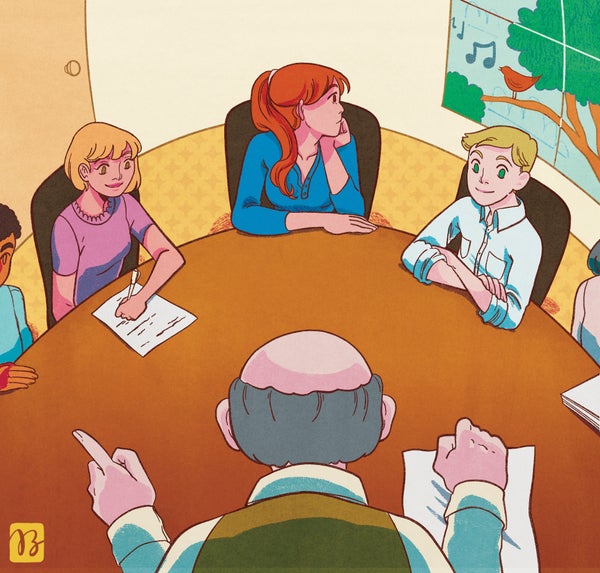October 15, 2024
4 min read
Kids with ADHD May Still Have Symptoms as Adults
Fortunately, recognition and treatment of attention deficit hyperactivity disorder in grown-ups are getting better

I know of someone who was diagnosed with attention deficit hyperactivity disorder (ADHD) as a child in the 1990s. When he turned 18, his insurance company notified him that his medication—a kind that gives kids with ADHD a better chance to succeed in school and can be quite pricey—was no longer covered. ADHD, the insurer said in effect, was a childhood disorder. What an unfortunate choice: to either struggle financially to pay for your medication or head into college or the workforce without the treatment that helps you.
The idea that ADHD was restricted to kids was deeply ingrained at the time. People thought “it was a developmental lag that just needed to catch up,” says psychologist Stephen Faraone of Upstate Medical University in Syracuse, N.Y.
But ADHD often continues into adulthood, multiple studies have now shown. The current estimated prevalence in adults is around 2.5 to 3 percent, compared with 5 to 6 percent in children. The 2013 edition of the Diagnostic and Statistical Manual of Mental Disorders (DSM-5) made it easier to diagnose adults, saying grown-ups can have five symptoms instead of the six required in children and acknowledging that ADHD might look different as people grow older. “They don’t climb on furniture and stuff like that,” Faraone says. (The DSM-5 still requires that some symptoms be present before the age of 12.) The first guidelines for diagnosing and treating ADHD in adults are now being developed by the American Professional Society of ADHD and Related Disorders.
On supporting science journalism
If you’re enjoying this article, consider supporting our award-winning journalism by subscribing. By purchasing a subscription you are helping to ensure the future of impactful stories about the discoveries and ideas shaping our world today.
In adults, the disorder can appear rather different than in youngsters. Grown-ups dealing with inattention and hyperactivity may have more difficulty than average completing long reports for work, sitting through meetings or restaurant meals, paying bills on time, or sustaining romantic relationships. “We’re shining a light on what’s probably really going on,” says clinical psychologist Margaret H. Sibley of the University of Washington School of Medicine, who worked on several of the new studies. “People in adult mental health settings just aren’t even being screened for it.”
Because of the lack of screening, many people who could benefit from treatment aren’t getting it, experts say. Also, it is likely that the rate in adults is higher than the 3 percent I mentioned earlier. A 2021 analysis showed that when based on symptoms alone rather than documented childhood onset, the rate in adults ranges from about 9 percent in young adults to more than 4 percent in those older than 60.
Some people do outgrow the disorder, though probably far fewer than previously thought. (It’s unclear whether people’s brains become more neurotypical over time or they learn to compensate.) A 2022 study in the Journal of American Psychiatry, led by Sibley, found that slightly more than 9 percent of people diagnosed as children had no sign of the condition as adults. Usually such people had milder symptoms and strong support from parents.
A more common scenario is that the severity of symptoms fluctuates. Previous studies tested people once in adulthood and gave a yes/no diagnosis. Sibley’s study retested teens and young adults multiple times and revealed that 60 percent of those who showed remission later experienced a recurrence. “It appears to be a condition that waxes and wanes,” Sibley says. “There is likely a role of environment in turning up or down the volume of somebody’s difficulties.” In other words, ADHD symptoms may tend to flare up when life gets stressful and ease when life is calmer.
Although a few studies have suggested it is possible for ADHD to appear for the first time in adulthood, more recent research indicates that adult onset is highly unlikely. Nearly all such cases are probably either misdiagnoses of another condition, such as substance use or anxiety, or instances in which childhood symptoms were missed, Sibley says.
Many parents—and even grandparents—first recognize their own symptoms when their child is diagnosed. This is particularly true of females with the disorder, whose behavior as children tends to be more inattentive than hyperactive like the stereotypical boy with ADHD. As adults, however, females are more likely than males to seek mental health treatment. “When you’re a child, you get mental health treatment if you cause someone else a problem,” Faraone says. “When you’re an adult, you go in because you have a problem.”
Most people who have been diagnosed with ADHD will try medication (usually stimulants such as Ritalin), but within the first year 40 to 50 percent discontinue the pills for at least 180 days, says psychiatric epidemiologist Isabell Brikell of the Karolinska Institute in Sweden. Reasons can include adolescent independence, increased costs and, for adults, providers less trained in treating ADHD. Thanks to parental oversight, children are more likely to maintain treatment, but a large study across eight countries showed that discontinuation rates peak for patients at the age of 18. “The transition from child and adolescent psychiatric care does not work well in many countries,” Brikell says.
The lack of proper treatment can raise other health problems. Brikell says several Swedish-led studies have shown that ADHD is associated with diseases that increase with aging, such as a slightly higher risk of hypertension and other cardiovascular diseases. The disorder has been linked to greater risks of obesity, substance use and sleep problems.
The good news is that because the medical community is increasingly aware of the nuances of adult ADHD, people experiencing difficulties have a better chance of getting a professional diagnosis. For grown-ups, Faraone says, proper treatment can be life-changing.
This is an opinion and analysis article, and the views expressed by the author or authors are not necessarily those of Scientific American.

